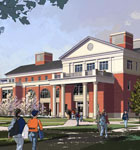Bucknell University desperately needed space. The small Pennsylvania school needed to add faculty but had no place to put the new staffers. In 2006, it undertook a campus master plan to determine its needs through 2015, and it decided to add at least one academic building. Thus Academic West was born—the idea of it anyway. With Bucknell’s Campus Greening Initiative assisting the project, the school sought a building designed to be LEED Silver certified. We talked with Dennis Hawley, associate vice president for facilities, and Dina El-Mogazi, director of the Campus Greening Initiative, about the new space.
How does the rooftop garden contribute to Academic West’s sustainability?
Dina El-Mogazi: What makes the roof green is that it’s a planted roof, using soil and plants to capture rainwater that would otherwise go toward runoff. It also insulates the building. We already have two green roofs but this third one will be much larger. It’s a system of liners and plants that allow roof to be planted without having any kind of leakage problems. It requires some maintenance, but not too much in the long run.
And that space will also be utilized for students and faculty?
Dennis Hawley: What’s nice about this one building is that it has three stories, but the third story is not a full footprint of the building. So the third story, which is mostly faculty offices and then a lounge area, will open onto a patio with an arbor overtop. We’ll have social activities overlooking the Susquehanna River, surrounded by a vegetated green roof. It’s going to be lovely.
How else does the building’s landscaping enable its efficiency?
El-Mogazi: The green roof is really just the beginning of a whole design that helps to filter and slow down storm water. The rainwater leaving the roof of the building will enter a storm-water system that’s visible through a channel running along top a landscaping retaining wall, which will filter into three rain garden areas at the edge of campus. Those will be planted with native plants.
What about the building’s power system? How did that contribute to the LEED certification?
Hawley: Bucknell has its own cogeneration plant that converts natural gas into two usable forms of energy: steam and electricity. So we can power everything rather than buying electricity or having a boiler. We actually had a coal-fire plant, which we converted into the cogeneration plant in 1998. It was a $12 million project, but has saved us about a million dollars a year. We generate 95 percent of our power, and the other 5 percent comes from wind-generated power.
How much did that project reduce your impact?
El-Mogazi: We’ve reduced our gas emissions by almost 40 percent. It’s hard to get that much of a reduction all at once, with one project. Now we have to work hard to find other things we can do to reduce that impact as well. Green building is part of that strategy.

